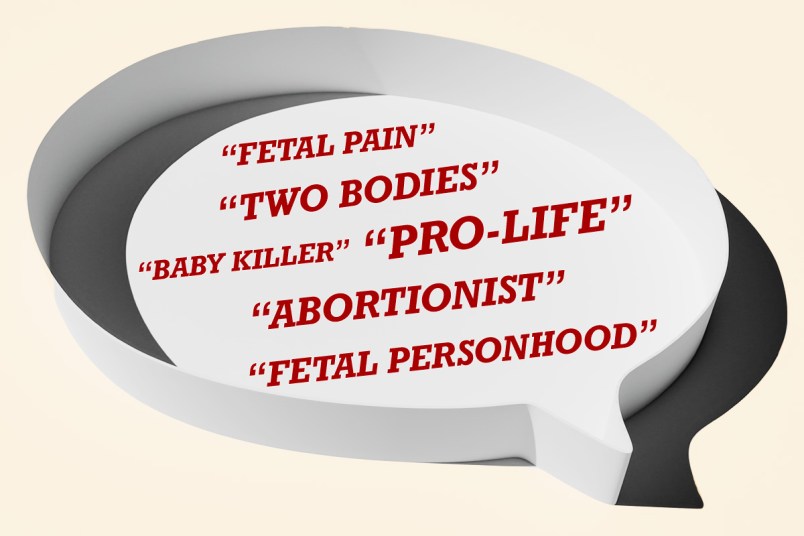The language and imagery of the anti-abortion movement are ubiquitous in American life.
From legislation called “fetal heartbeat” bills to a constitutional amendment named “Value Them Both” to references to “abortionists” and “fetal pain” in the leaked draft Supreme Court majority opinion — they have permeated American political life.
But the messaging hasn’t been restricted to the community of policymakers and activists who debate these issues.
“Every single American has come into contact with anti-abortion messaging and fetal imagery at some point in their lives,” Jennifer Holland, assistant professor of U.S. history at the University of Oklahoma, told TPM.
That message discipline, often bolstered by pseudoscientific half-truths or unvarnished lies, is a hallmark of a movement on the precipice of its greatest success yet: bringing about the end of a constitutional right to abortion.
Anti-Abortion As Rights Movement
In its earliest days, anti-abortion leaders were trying to figure out how to situate themselves in the national dialogue, how to present their mission in a sympathetic and compelling way to a populace that was, at the time, wary about the group imposing its religious views on other people.
Some compared themselves to white southerners, trying to hijack the “lost cause” and reconstruction rhetoric of federal government intrusion into a way of life, Holland said. But they struck gold in the early 70s, when they turned to the civil rights movement for inspiration.
“The anti-abortion movement was being born in a moment when the civil rights movement was being reimagined and placed within the tradition of American progress and rights expansion,” Holland said.
Anti-abortion activists could paint themselves as abolitionists, crusaders for a new kind of human right. It also made the movement attractive to young conservatives, who were eager to join what could be cast as a social justice movement.
Around the same time, the Holocaust was beginning to enter American consciousness in a new way. It was starting to be taught in schools, and became, as Peter Novick, author of “The Holocaust in American Life,” put it: “a shocking, massive, and distinctive thing.”
The anti-abortion movement saw in it another useful narrative.
“They immediately picked up on this and really relied heavily on the idea that America has turned away from its commitment to rights, and is also on a slippery slope towards Hitler’s Germany,” Holland said. “They said that when you devalue certain life, it opens up devaluing all life, like the killing of the elderly or anyone you see as lesser.”
The comparison of abortion to the Holocaust and lynchings of Black people became a mainstay of the movement in the ‘70s and ‘80s, and still hasn’t completely died out: a 2009 article from the Ohio State student newspaper describes the “Genocide Awareness Project” placing on campus gory images of fetuses next to posters of a racial lynching, Holocaust victims and the September 11 attacks. In 2011, anti-abortion protesters at Princeton handed out literature depicting nooses, asserting that “in the new Klan, lynching is for amateurs.”
While they liken abortion to these historical atrocities, they also argued that abortion is worse since it has “killed” more people, and inherently precious ones.
“Unborn babies are innocent in a way that no one else can be,” Holland said.
As this language built over time and became subsumed into the movement, it helped lead to the rash of extreme violence at abortion clinics in the mid-1980s and 1990s. Termed the “rescue movement,” activists would physically blockade access to clinics, keeping patients and providers from entering the facilities. A successful day, the activists reasoned, was one where no abortions occurred.
That escalated into murders of abortion providers, clinic workers and security guards alongside shootings, bombings, kidnapping and arson.
During Justice-In-Waiting Ketanji Brown Jackson’s confirmation hearings, Democratic senators recalled that time in response to criticisms that Jackson had pejoratively described the anti-abortion protesters who scream at women on their way inside for the procedure.
“This was an atmosphere of guns, terror, screaming, murder — it was a grim time,” Sen. Sheldon Whitehouse (D-RI) said.
The violence prompted passage of the Freedom of Access to Clinic Entrances Act (FACE) Act, signed by then-President Bill Clinton in 1994 — one of the very few pieces of abortion legislation passed on the federal level.
But it didn’t demolish the movement. Many anti-abortion activists feel just as ardently now as they did then that abortion is murder, and have amassed legislative and legal wins based on and infused with that “pro-life” conviction.
Bolstered By The Pseudoscientific
Along with painting itself as a critical civil rights movement, the anti-abortion movement from the beginning latched on to pseudoscientific claims to shroud itself in the terminology of biology and medicine rather than religion.
That effort involved a stable of anti-abortion physicians who would substantiate the movement’s claims, even when they were outside of the medical mainstream. It also presented a difficulty for the abortion rights movement that persists today: It’s much easier to fit “life begins at conception” on a bumper sticker than its medically valid rebuttal.
The Guttmacher Institute, a research organization seeking to advance reproductive rights, is considered the gold standard in the industry. So the anti-abortion movement set up the Charlotte Lozier Institute to try to fight back.
“They want to be scientific, but again and again are discredited,” Carole Joffe, a sociology professor at the University of California, Davis’ center for global reproductive health, told TPM. She added that the institute has helped perpetuate the falsehood that abortion increases a woman’s chances of getting breast cancer.
There’s also been an effort in the movement to bolster claims that abortion presents a widespread and lasting harm to women’s mental health — something that the major medical associations have repeatedly debunked.
In some states, local laws mandate that providers regurgitate these lies, plucked straight from the anti-abortion movement, to pregnant patients.
“I was interviewing a clinic director from Texas who was telling us about what it’s like to tell patients lies,” Joffe recalled. “‘I was telling her that you may get breast cancer and may never conceive child if you get an abortion,’ the director said. The patient broke down crying, saying, ‘if it’s not true why are you telling me this?’”










